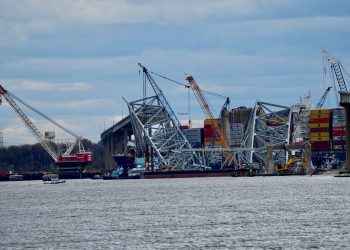The Baltimore bridge disaster is sending shockwaves through the maritime industry, laying bare the vulnerabilities inherent in everyday operations, and underscoring the value of proactive risk management measures, Ed McNamara, CEO, Armada Risk Partners argues.
As specialist crews and authorities focus on operations to remove the Singaporean-flagged container ship Dali that slammed into the Francis Scott Key Bridge, there is a notable lack of a firm timetable to fully open the Port of Baltimore more than six weeks after the event.
Total damages and costs continue to rise and are likely to run to several billions of dollars. While it is reported that Chubb is preparing to pay out $350 million in the near future as insurers of the bridge, it will cover only a fraction of the total costs associated with the March 26 bridge collapse.
The ensuing disruption has not only impacted maritime commerce but unleashed a cascade of consequences, which disrupt trade routes, strand vessels, and put at risk global supply chains creating significant economic losses.
Ports find themselves at the forefront of risk. Whether it is a ship incident, as in the case of Baltimore, or an extreme weather event, a port can quickly become blocked rapidly exposing operations, assets and people to severe disruption, damage, and third-party claims.
We believe that port blockage insurance offers a critical and pragmatic solution to this pressing issue. By providing coverage for losses resulting from port closures or blockages, insurers can help ports mitigate financial risks and expedite recovery efforts.
Yet we continue to see a number of port operators who are considering cutting their coverage as a short-sighted route to saving money in the face of rising rates and premiums.
While some operators are of the opinion that federal authorities will unblock their port in times of crisis given the urgency of moving essential supplies, Baltimore has clearly shown this to be a high-risk strategy. Not only might it not even be physically possible to unblock a port immediately, but the authorities can also be already occupied with other emergencies or, indeed, be struggling with the challenges of bureaucracy.
In situations like this which paralyze or seriously curtail port operations, the net result is the likelihood of extensive delays, stranded vessels, disrupted global supply chains, and a massive economic hit.
Port blockage insurance should not be seen as a luxury; it is more of a strategic imperative. Just as we all insure our homes against natural disasters, ports should take the necessary steps to safeguard their operations from the significant risks of maritime transportation.
This specialized insurance provides financial protection in the event of port closures or blockages, ensuring that ports can mitigate losses, expedite recovery efforts, and swiftly resume operations. It also incentivizes investments in infrastructure resilience and emergency preparedness. Insurers can collaborate with port authorities and businesses to identify vulnerabilities, implement mitigation measures, and enhance response capabilities.
By fostering a culture of risk awareness and proactive risk management, we can reduce the likelihood and severity of future disruptions. This investment in resilience and preparedness, will allow us to fortify global supply chains, promote economic stability, and ensure the uninterrupted flow of goods and commerce.
The views presented hereabove are only those of the author and do not necessarily reflect those of SAFETY4SEA and are for information sharing and discussion purposes only.

































































